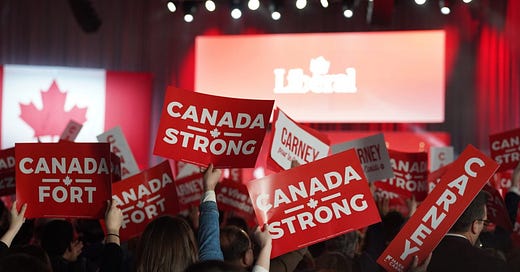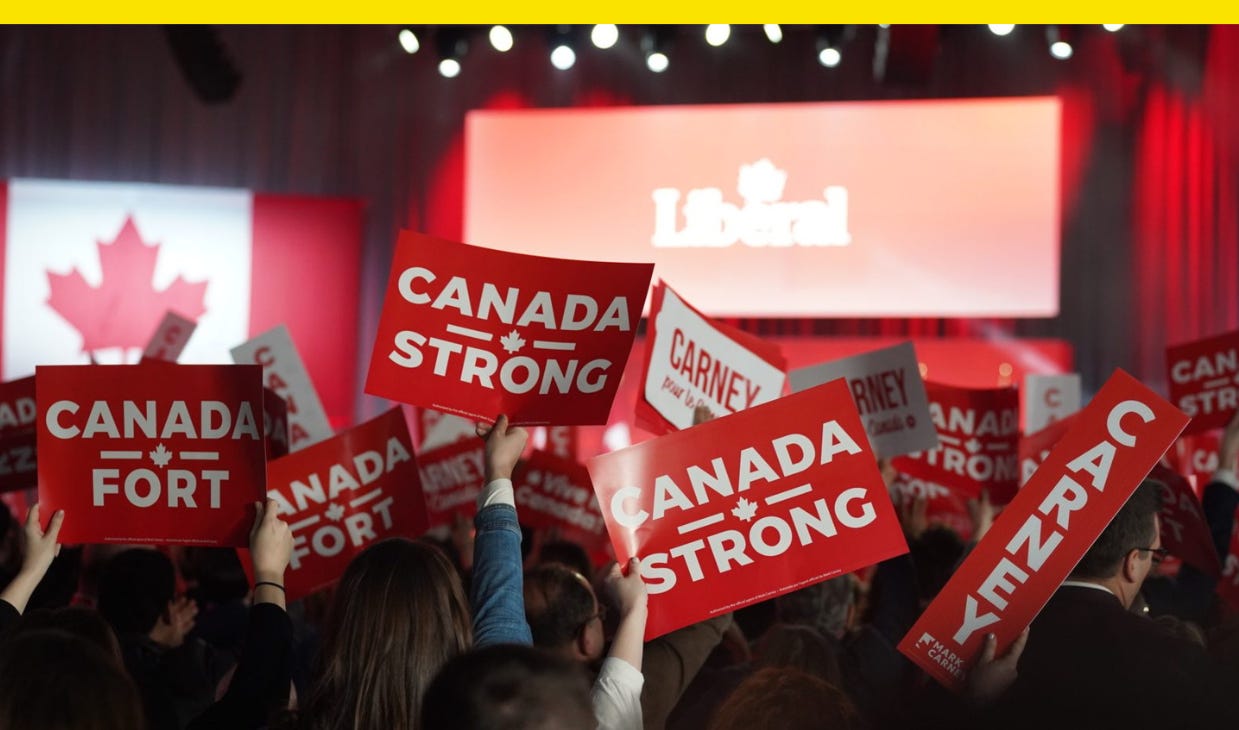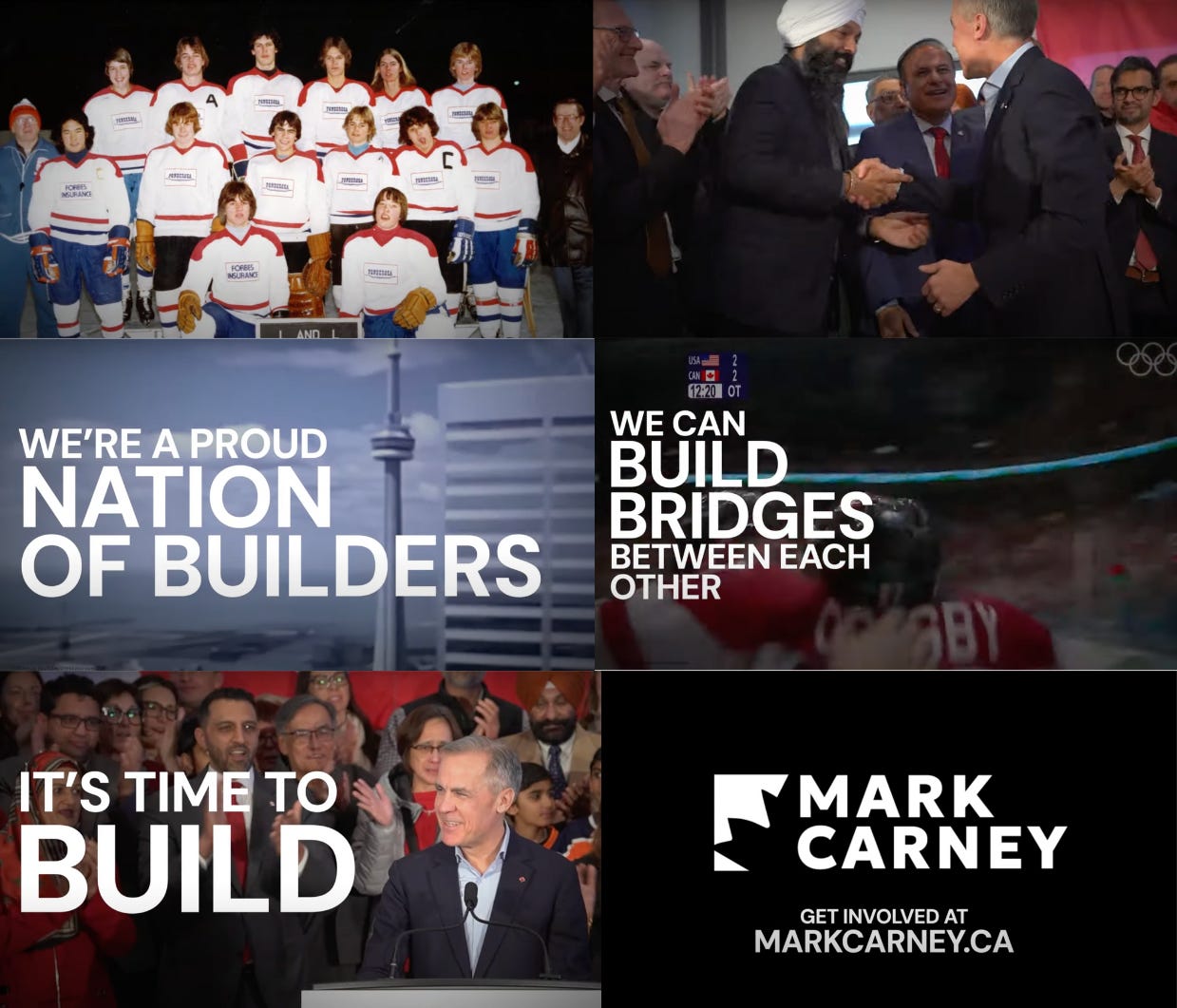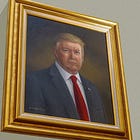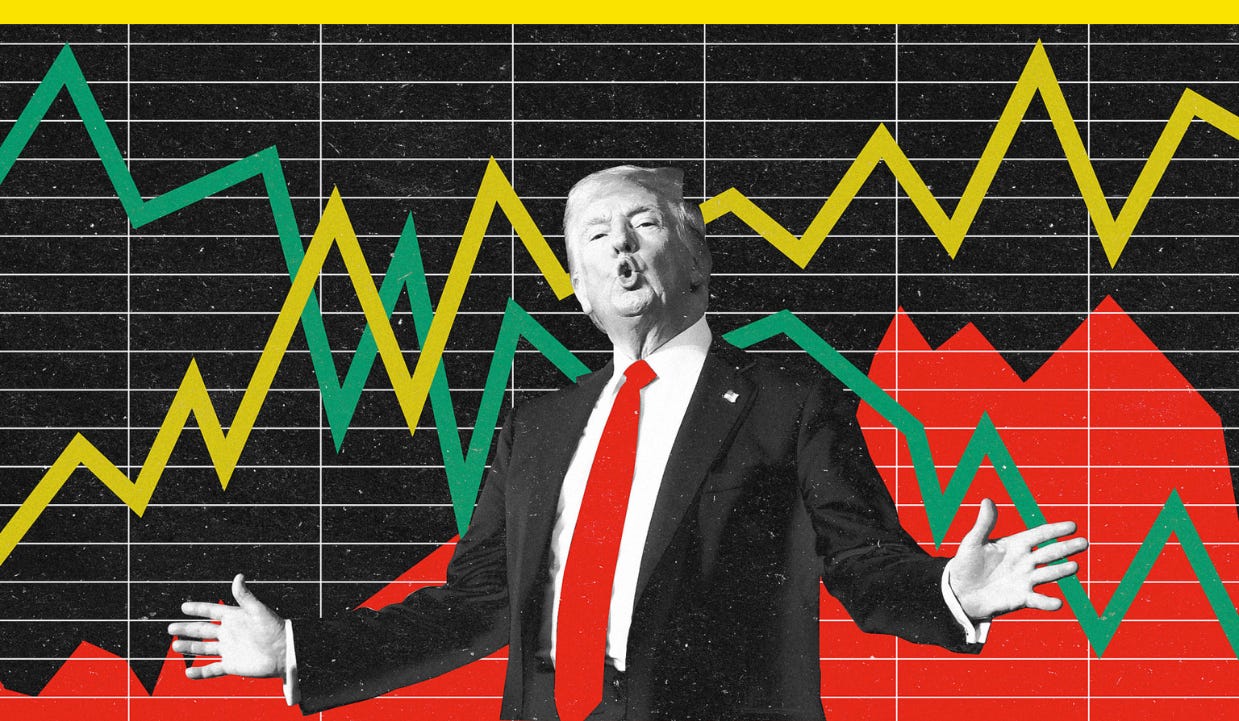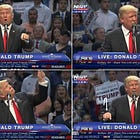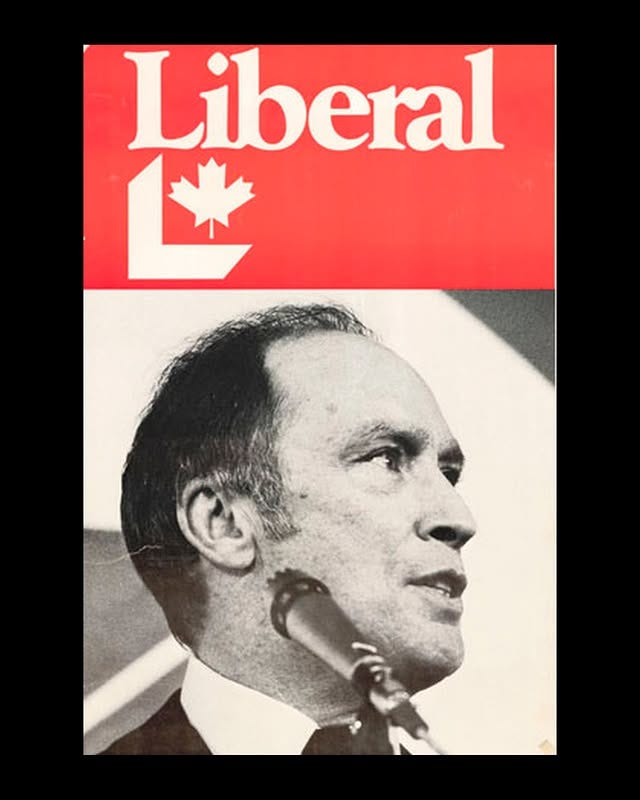The patriotic branding of Canada’s Liberal campaign is aggressively Canadian
Plus: Trump’s trying to make “liberation day” happen
The patriotic branding of Canada’s Liberal campaign is aggressively Canadian
You’d be forgiven for mistaking Canadian Prime Minister Mark Carney’s campaign branding for that of Canada’s national hockey team.
Signs held by attendees at a victory celebration in Ottawa last month after the Liberal Party announced Carney won the party’s leadership race, and thus the premiership, we’re a patriotic red and white, the colors of the Canadian flag, with the bilingual slogan “Canada Strong,” or “Canada Fort” in French for our friends in Quebec.
In adopting a phrase used by cities and sports teams responding to disasters and tragedies into a political response to President Donald Trump’s saber rattling, Carney is seeking to communicate a message of Canadian unity, strength, and resilience. Nationalism is 2025’s hottest merch trend, and it turns out, it can make for a pretty compelling campaign message too. In short order, Carney’s team has built an identity that may well show the left how to build a campaign brand that’s both patriotic and progressive while standing up to Trumpism.

“We’ve never had an election like this,” Grant Gordon, president and creative director at the Toronto creative agency Key Gordon, which has done branding work before for political parties, tells me. “Canadians are typically unpatriotic. Our national elections are usually inward facing, as one would expect.” This one, though, is different. It’s existential. “It’s about the very survival of our country. It’s about who can best deal with Trump. Period. All of a sudden flags are everywhere.”
With Carney calling a federal election for later month, his “Canada Strong” message is the basis for a Liberal Party brand that’s seen its fortunes improve since Trump took office in the U.S. and former Canadian Prime Minister Justin Trudeau stepped down. After trailing the Conservative Party, Liberals pulled ahead in the first week of the campaign, according to Ipsos polling.
“The level of patriotism in this election is new to both parties,” Gordon says. “Canada is usually a tangled mess of regional interests: French vs. English, East vs. West, but all that has changed. Donald Trump, his trade war, and the specter of annexation is the first thing other than our national hockey team that has united us since World War II. You probably think I’m joking, but I’m not.”
When Carney, a former governor at the Banks of Canada and England, announced his candidacy for Liberal leadership in January, he used a logo that created a letter M from negative space in the shape of a maple leaf. It resembled the logo of MetCredit, a Canadian debt collection agency, so much so that the company’s CEO responded to Carney’s announcement on X.
“That’s a beautiful logo Mark but we’re apolitical,” MetCredit CEO Brian Summerfelt wrote. In a follow-up email, Summerfelt said the company’s logo “is a registered trademark. The one created for your campaign is too close for comfort,” and asked, “Please cease using it. Thank you,” according to the Toronto Sun. Summerfelt told the Sun the Carney campaign quickly called him, apologized, and changed its logo. Carney’s new mark uses a close crop of a maple leaf and his name in all caps in a sans-serif font.

Gordon, the creative agency president, says Carney’s logo is “clean, simple, and serious” and “visually boring, but in this case I think boring works.”
“It seems to me the country needs a leader who is calm and steady and yes, a bit boring. The Carney visual identity reflects this,” he says. “When the stakes are high, people want the straight goods, they don’t need or want any artistry, so I think the Carney branding is right for the times and right for the leader.” As for the “Canada Strong” slogan, he finds it derivative and thinks “they could have done better.”
The day before calling the election, Carney posted a video with comedian Mike Myers who wore a “Never 51” Canadian hockey jersey. The video as well as follow-up videos with Myers used a well-known and well-liked Canadian celebrity to communicate a message that Canada won’t be bowed. It’s about toughness and standing up to Trump. Or “elbows up,” as hockey players put it.
In his biographical “Why I’m Running” announcement video, Carney, a political newcomer, introduced himself to voters who might be unfamiliar with him. The video opens with a shot of Carney’s interview with an American, Jon Stewart, before honing in on his Canadian credentials — born in Fort Smith, Northwest Territories, raised in Edmonton, Alberta, and played hockey (he was a goalie, naturally) — before laying out his experience for office.
The video emphasizes Carney’s record working across party lines and across national borders (he was the first non-British person to head the U.K.’s central bank) and argues he’s up to the task of responding to Trump and his imitators, Conservative Leader Pierre Poilievre among them. “You can’t stand up to Trump when you’re working from his playbook,” Carney says. A crowd that Carney’s shown speaking in front of is diverse and multiracial and there’s B-roll of the Team Canada men’s hockey team beating the Americans in overtime when Carney says the line “we can build bridges between each other.”
Carney’s closing message of the video is that it’s “time to build,” something he’s emphasizing in his policy proposals. On Monday, he announced a plan to double the pace of homebuilding in Canada. His two current TV spots liken Poilievre to Trump and hit Poilievre for saying “everything is broken” all the time.
We’ll know whether Canadian voters find Carney’s message compelling by Canada’s Election Day on April 28, but it makes for an interesting case study. National pride need not be right-wing and nativist, it can actually encompass values like community and togetherness and still present an optimistic, muscular vision of the future.
Previously in YELLO:
Trump’s trying to make “liberation day” happen
Trump’s tariffs are unpopular and expected to raise costs for Americans, but he’s trying his best to message them in a positive light. When his proposed new tariffs on foreign goods go into effect on Wednesday, he’s calling it “liberation day.”
“We have ‘liberation day,‘” Trump said last week. “Many countries have taken advantage of us, the likes of which nobody even thought was possible for many, many decades.”
Trump has long been one for hyperbole, and when it comes to trade, he’s not holding back, calling the word tariff “the most beautiful word in the dictionary.” But the choice of “liberation day” to describe tariffs is a true misnomer.
In Europe, Liberation Day is observed by countries in celebration of the liberation from Nazi Germany. For Trump, he simply uses the phrase to describe a day on which he enacts his agenda. Already, Trump called his 2025 Inauguration in January “liberation day” during his speech, and he’s repeating the phrase to apply to tariffs hitting Wednesday.
For words and phrases to take hold, both inside and outside of politics, they must meet the FUDGE test, according to the mnemonic device devised by linguist and Predicting New Words author Allan Metcalf. He wrote that new words need to meet a threshold for frequency, unobtrusiveness, diversity, generating new forms and meanings, and endurance in order to take hold. In other words, they need to be simple to pick up, used a lot, and able to be used flexibly across different groups and in different ways.
Trump is a master of bumper sticker-style slogans and political rhetoric, repeating straightforward, memorable phrases to explain his political agenda that becomes widely used, like “America first” and “drain the swamp.” Perhaps the best example is his already tired campaign slogan, “Make America Great Again,” which he cribbed from Ronald Reagan. That became so ubiquitous in Trump’s rhetoric that it spawned an acronym and inspired spin-offs, like “Make America Healthy Again.”
Whether “liberation day” can similarly take hold remains to be seen. For Daniel Rogers, a Princeton University history professor who’s studied political rhetoric, the phrase is a distraction tactic.
“Changing the subject has always been one of Trump’s favorite tactics,” Rogers tells me. “Don’t engage with those who want to know on whom the cost of tariffs is going to fall, or what steep new tariffs will mean for the cost of living. Get people to believe that tariffs will free the nation from the oppressive trade policies of the commercial enemies that surround it. Get them to think that there’s a ‘war’ going on, and that tariff is another, beautiful word for ‘victory.‘”
Whether voters outside Trump’s base ever find his trade-war rhetoric convincing seems unlikely. A 55% majority of U.S. adults believe the Trump administration is focusing too much on tariffs and 64% think it’s not doing enough to lower prices, according to a CBS News/YouGov poll released Sunday. It’s not as if Americans squeezed by years of post-pandemic inflation will greet as “liberators” the higher costs that tariffs will add to cars, housing, food, and other regularly purchased goods.
Have you seen this?
The strategy behind Trump’s repeated musings about a third term. The president’s comments deflect attention from other controversies. And they freeze the field of potential successors who might steal the spotlight from a lame duck. [New York Times]
How the Harris campaign blew the Latino vote. Internal consternation and budget cuts for Latino outreach hobbled the Harris campaign’s efforts to reach a critical voting bloc in the weeks and months leading up to Election Day, according to one of her chief bilingual ad makers. [Campaigns & Elections]
Wisconsin provides a critical test of Democrats’ anti-Elon Musk playbook. Democrats, who've struggled to find their footing in the second Trump administration, have made Musk a major focal point in the final stretch of the Wisconsin Supreme Court race. [NBC News]
Trump’s actually spending more than Biden. Don’t let the DOGE distract you, Trump’s administration is actually on track to spend more money than the last guy, according to a new report. [Whig]
History of political design
Canadian Liberal Party graphic for former Prime Minister Pierre Trudeau (ca. 1960s-80s). Though national pride hasn’t always been big in Canadian politics, the maple leaf is a ubiquitous symbol in Canada and used in all federal party logos.
A portion of this newsletter was first published in Fast Company.
Like what you see? Subscribe for more:

